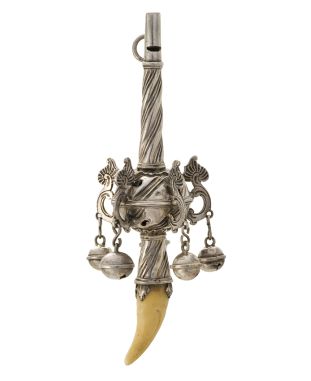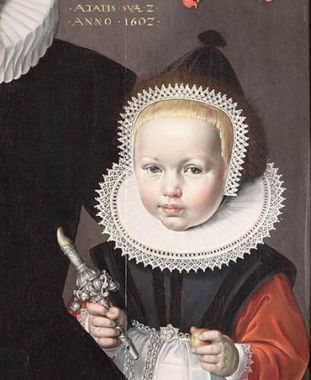
A baby rattle with wolf tooth
Unknown maker, silver and wolf tooth, c. 1600-1610. Inv. nr. 0114

Detail from the Sonck family portrait
Jan Claesz, oil on panel, 1602. coll. Westfries Museum, Hoorn (Netherlands)
2013-07-12

Wolf tooth!
This unique early 17th-century rattle from the Keijser Collection is set with a wolf’s tooth. Since ancient times, wolf’s teeth have been used as charms to protect their carriers against evil spirits and/or illness. Because of these protective powers, wolf’s teeth were frequently converted into teethers or baby rattles from the 16th century onwards.
Wolf teeth were not the only wolfs parts that were considered wholesome: in his History of Nature, the ancient philosopher Plinius argued that a wolf’s excrements could be used to heal eye-diseases, and powder from a ground wolf’s head would help to ease soaring tooth-aches.
One of the first authors to write about the use of wolf teeth in silver baby rattles was Jean de Clamorgan, who published a book about wolf hunting in 1571. Clamorgan states:
‘When bound on a child’s body, wolf teeth help to soothe the child and to ease their teething-pains. For that purpose, many Parisians have cultivated the use of wolf teeth, by hanging small toys around their childrens’ necks, that are referred to as ‘rattles’ (hochets). These toys are made of silver and they contain a large wolf’s tooth. While playing, children will chew on the rattle with their gums, making teething easier and less painful.’
This rattle resembles the rattle in the hand of the son of the Mayor of the Dutch city of Hoorn Albert Fransz Sonck (1571-1658) in the family portrait from 1602 in the collection of the Westfries Museum in Hoorn. The portrait can be seen on the museum's website.
Sources:
Marc Jacobs, 'Zoethouder, klater of scepter? Functies van de betere hybride rammelaars sinds de middeleeuwen'. In: cat tent. Klatergoud en zilveren bellen, Zilvermuseum Sterckshof, 2009.
Further information:
See object description: Inv. nr. 0114. For other rattles with wolf tooth in the Keijser Collection see Inv. nr 0115 en Inv. nr. 0116
Wolf teeth were not the only wolfs parts that were considered wholesome: in his History of Nature, the ancient philosopher Plinius argued that a wolf’s excrements could be used to heal eye-diseases, and powder from a ground wolf’s head would help to ease soaring tooth-aches.
One of the first authors to write about the use of wolf teeth in silver baby rattles was Jean de Clamorgan, who published a book about wolf hunting in 1571. Clamorgan states:
‘When bound on a child’s body, wolf teeth help to soothe the child and to ease their teething-pains. For that purpose, many Parisians have cultivated the use of wolf teeth, by hanging small toys around their childrens’ necks, that are referred to as ‘rattles’ (hochets). These toys are made of silver and they contain a large wolf’s tooth. While playing, children will chew on the rattle with their gums, making teething easier and less painful.’
This rattle resembles the rattle in the hand of the son of the Mayor of the Dutch city of Hoorn Albert Fransz Sonck (1571-1658) in the family portrait from 1602 in the collection of the Westfries Museum in Hoorn. The portrait can be seen on the museum's website.
Sources:
Marc Jacobs, 'Zoethouder, klater of scepter? Functies van de betere hybride rammelaars sinds de middeleeuwen'. In: cat tent. Klatergoud en zilveren bellen, Zilvermuseum Sterckshof, 2009.
Further information:
See object description: Inv. nr. 0114. For other rattles with wolf tooth in the Keijser Collection see Inv. nr 0115 en Inv. nr. 0116




